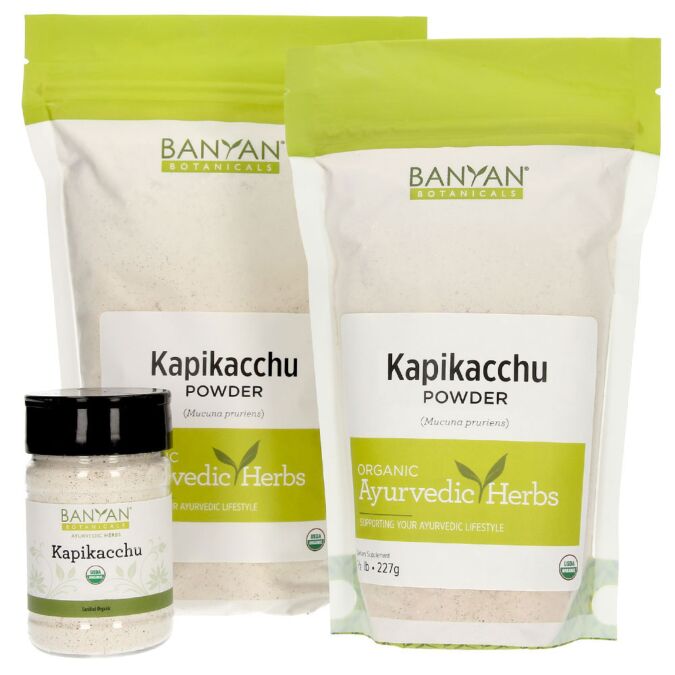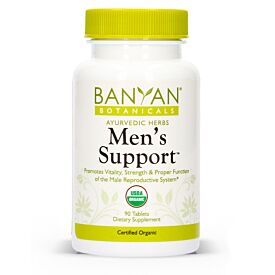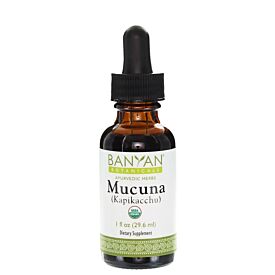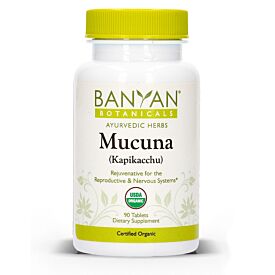Mucuna pruriens, seed powder
Rejuvenative for the Reproductive & Nervous Systems*
- Supports the proper function of the reproductive system*
- Promotes a healthy state of relaxation and calm*
- Soothes the nervous system*
- Natural source of levodopa (L-dopa)*
Mucuna pruriens, known in Ayurveda as kapikacchu, is a nutritive tonic commonly used to nourish the nervous system, support healthy sexual energy, and strengthen and tone the reproductive organs. Mucuna encourages natural fertility, a healthy libido, and helps build ojas, the essence of virility, vitality, and immunity. The vitality bestowed by mucuna nourishes the entire body and calms the nerves, making it an excellent rejuvenative for vata. By balancing vata in the nervous system, mucuna supports the body’s ability to maintain healthy muscular movements, proper sensation, coordination, and keen motor skills. It is also a natural source of levodopa (L-dopa), which is an essential precursor to the neurotransmitter dopamine. This mucuna is grown in the region of Rajasthan, India, and is certified organic and Fair for Life.*
Herbal tablets that contain Kapikacchu seed include:
Healthy Vata, Men’s Support, Stress Ease
Other products that contain Kapikacchu seed include:
Mucuna (Kapikacchu) liquid extract
USDA Certified Organic
When you purchase certified organic herbs from Banyan Botanicals, you can be confident that you are making a healthful choice, while also contributing to a healthier planet. In order to meet the USDA’s stringent organic standards our entire line of supply is regularly inspected by independent 3rd party certifying agencies.
Learn MoreFairly Traded Herbs
Banyan Botanicals is committed to trading fairly with everyone involved in the farming and production of our herbs.
Learn MoreSustainable Sourcing
Many widely used plants are threatened and in danger of being unavailable either through extinction or protective legislation. Banyan Botanicals is working to reverse this trend by supporting sustainable projects that use ecologically friendly methods of farming and harvesting.
Learn MoreFair For Life
Fair for Life is a fair trade certification that looks at the entire journey of an ingredient, from harvest to the final product sold to our customers. It also goes beyond labor—it certifies social and environmental responsibility across an entire supply chain and within an entire business.
Product Details
Ayurvedic Energetics:
- Rasa (taste): sweet, bitter
- Virya (action): heating
- Vipaka (post-digestive effect): sweet
- Doshas (constitutions): Balancing for vata and pitta, may increase kapha
Suggested Use:
¼ to ½ teaspoon with warm water, once or twice daily, or as directed by your health practitioner.
Please consult with your health care practitioner prior to the use of this product if you are pregnant or nursing, taking medications, or have a medical condition. Keep out of the reach of children.
Kapikacchu Seed Powder (Mucuna pruriens)
This product is organically grown and processed in accordance with the USDA's National Organic Program (NOP).
This item contains no animal products and is suitable for vegetarians and vegans.
California Customers: WARNING
- How much kapikacchu is recommended to take each day?
- How do I use kapikacchu to support my overall reproductive system?
- What herbs can I include with kapikacchu to support my reproductive system?
- How do I use kapikacchu to assist in healthy libido and stamina?
- How do I use kapikacchu to help manage stress?
- Why is kapikacchu such a great herb for supporting my nervous system?
- How do I use kapikacchu to support my nervous system?
- How do I use kapikacchu to help balance my vata?
- Why are many of the suggested ways to use kapikacchu the exact same while the reason for taking it can be entirely different?
- Are mucuna and kapikacchu the same herb?
- How many milligrams are in a teaspoon of kapikacchu?
- What is levodopa, or L-dopa, and how is it related to kapikacchu?
- How much levodopa is in your kapikacchu?
- What can you tell me about the relationship between kapikacchu’s L-dopa and Parkinson’s disease?
- Where does your kapikacchu come from?
1. How much kapikacchu is recommended to take each day?
Our general suggestion is to take anywhere from ¼ to 1 teaspoon per day, and you can use this range in all of the following suggestions. There is a broad range because each situation is different and each person may need more or less of an herb to bring balance. Try starting with a lower amount and build over time until you reach your desired amount.
2. How do I use kapikacchu to support my overall reproductive system?
Kapikacchu can be used on its own by adding up to one teaspoon of the powder in to warm water. Alternatively, warm milk can be used in place of water as milk is also a good vehicle for taking kapikacchu. Bring the milk and kapikacchu powder to boiling point, then remove from heat and let cool to a comfortable temperature before drinking. This can be taken in the morning and the evening.1
3. What herbs can I include with kapikacchu to support my reproductive system?
Kapikacchu is often used in combination with amalaki, ashwagandha, shatavari, vidari kanda, and gokshura for added reproductive support.2 Many of these herbs are a part of Men's Support and Stress Ease formulas.
4. How do I use kapikacchu to assist in healthy libido and stamina?
Use the same suggestions given for supporting your reproductive system (questions 2 and 3) as they will also support healthy libido and sexual stamina. If you would like to make your own powdered formula, use equal parts of kapikacchu, amalaki, ashwagandha, shatavari, and gokshura, add to warm milk or ghee, and take in the morning and evening. In Ayurveda, both milk and ghee are considered to be natural aphrodisiacs, which further supports your intention.3
5. How do I use kapikacchu to help manage stress?
Kapikacchu powder can be added to warm water or warm milk, and you can enjoy this at any time in the day or evening. Stress Ease is another option: this formula combines kapikacchu with ashwagandha, shatavari, brahmi/gotu kola, and guduchi (among other herbs), and it is a rejuvenating and nourishing formula that helps you cope with stress.
6. Why is kapikacchu such a great herb for supporting my nervous system?
Kapikacchu is a nervine and a tonic, and both qualities support the nervous system.4 Kapikacchu is a natural source of levodopa, or L-dopa, which is a precursor to the neurotransmitter dopamine. This is a technical way to say that it can help you feel calm and relaxed.
7. How do I use kapikacchu to support my nervous system?
Add the powder to a cup of warm milk and a little honey; the combination with milk and honey will enhance kapikacchu’s restorative qualities.5 You can use ghee as an alternative to milk if you desire. Ghee will also support kapikacchu’s restorative qualities. Take it at night to fully experience the herb’s rejuvenative effects: the herb will work while your body sleeps.
Stress Ease tablets are another option: the majority of the herbs in the formula – kapikacchu, ashwagandha, brahmi/gotu kola, guduchi, and gokshura – are all excellent for supporting a healthy nervous system.
8. How do I use kapikacchu to help balance my vata?
Making a nourishing, warming tea is a great option: add the powder to warm milk or water and drink it at any time that works for you. You can also take Healthy Vata; as the name implies, this formula was created to bring balance to vata. It harnesses the energy of kapikacchu and enhances its ability to support vata by combining it with many other herbs that can address vata imbalances.
9. Why are many of the suggested ways to use kapikacchu the exact same while the reason for taking it can be entirely different?
Kapikacchu works in different systems within the body, especially the nervous and reproductive systems,6 and it has different actions that helps the body regain balance in these different systems – it is a nervine, tonic, and aphrodisiac, to name a few.7 You can use the same mode of intake for different situations (for example, add it to warm water or warm milk), and kapikacchu will go where it is needed in your body.
While you can enjoy kapikacchu on its own, you can also enhance kapikacchu’s efficacy in a particular system by taking some of the herbal combinations suggested, or try our formulas in tablet form that contain kapikacchu, such as Healthy Vata, Stress Ease, or Men's Support. The herbs complement each other: the presence of the other herbs not only help direct kapikacchu’s potency within the body to a particular area, but they also bring out every other herb’s actions, making the formulas well-rounded and effective.
10. Are mucuna and kapikacchu the same herb?
Yes! Kapikacchu is the Sanskrit name, while “mucuna” is part of kapikacchu’s botanical name (Mucuna pruriens). Banyan uses both: we sell our bulk powder under the name kapikacchu while we sell our liquid extract as mucuna. Though we use different names, it is the same herb.
11. How many milligrams are in a teaspoon of kapikacchu?
There are approximately 3500mg of kapikacchu in one teaspoon.
12. What is levodopa, or L-dopa, and how is it related to kapikacchu?
Levodopa, commonly called L-dopa, is an amino acid that is naturally found in kapikacchu. L-dopa is a precursor to the neurotransmitter dopamine.
13. How much levodopa is in your kapikacchu?
The concentration of Levodopa in our kapikacchu is approximately 4-5 percent. Concentrations can vary from season to season depending on environmental conditions.
14. What can you tell me about the relationship between kapikacchu’s L-dopa and Parkinson’s disease?
Dietary supplements such as kapikacchu are not intended to treat, cure, or prevent any disease. Kapikacchu is a natural source of L-dopa and supports a healthy nervous system. Whether it is useful for people with Parkinson’s disease is a matter to discuss with your health practitioner.
15. Where does your kapikacchu come from?
Our kapikacchu is grown and harvested in Karnataka, India. This creeping vine can be found all over India, and it especially loves tropical regions, making Karnataka an ideal environment.
References
1 Dr. David Frawley, OMD, Ayurvedic Healing: a Comprehensive Guide (Salt Lake City: Passage Press, 1989), 294.
2 Dr. David Frawley and Dr. Vasant Lad, The Yoga of Herbs (Twin Lakes: Lotus Press, 2001), 245.
3 Frawley, Ayurvedic Healing, 295.
4 Swami Sada Shiva Tirtha, The Ayurvedic Encyclopedia: Natural Secrets to Healing, Prevention, & Longevity (Bayville: Ayurveda Holistic Center Press, 1998), 91.
5 Sebasatian Pole, Ayurvedic Medicine (London: Singing Dragon, 2013), 206.
Recommended Content
Reviews and Questions

Stay Balanced with
Banyan AutoShip
How It Works:
- Get your favorite products discounted and delivered automatically.
- Manage frequency, delivery, and quantity anytime through your account.
- Receive an email reminder before each delivery.
- Adjust or reschedule orders easily online.









